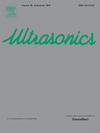具有成本效益的激光二极管扫描三维光声显微镜黑色素细胞真皮肿瘤原位。
IF 4.1
2区 物理与天体物理
Q1 ACOUSTICS
引用次数: 0
摘要
黑色素瘤皮肤癌的治疗包括广泛切除,然后进行组织病理学分析以确认诊断,这只能通过浅表皮肤镜检查来指导。因此,皮肤肿瘤学可以从光声显微镜提供的高分辨率3D图像中受益;然而,其临床转化受到其高成本的阻碍。打开了点护理3D黑色素瘤评估的途径,我们提出了一种具有成本效益的光声显微镜(CePAM)的首次演示,该显微镜利用反射模式下聚焦换能器的快速激光二极管扫描。直接模型反演(DiMI)算法的新应用允许将换能器声焦点以外的图像视场扩大55倍,达到1平方毫米的均匀灵敏度激光扫描区域(>20 dB)。此外,DiMI通过多选择平面扫描提高了系统的固有轴向分辨率。通过对小鼠黑色素细胞真皮肿瘤的幻影和体内成像的定量测试,证明了CePAM的可行性,产生了准确的3D图像和与组织学一致的虚拟横截面。本文章由计算机程序翻译,如有差异,请以英文原文为准。
Cost-effective laser diode scanning 3D photoacoustic microscopy of melanocytic dermal tumors in situ
Management of melanoma skin cancer involves a wide excision followed by histopathological analysis to confirm the diagnosis, which is only guided by superficial dermoscopy. Dermatological oncology can thus benefit from high-resolution, 3D images provided by photoacoustic microscopy; however, its clinical translation is hindered by its elevated cost. Opening a pathway to point-of-care 3D melanoma assessment, we present the first demonstration of a cost-effective photoacoustic microscope (CePAM) utilizing fast laser diode scanning with a focused transducer in reflection mode. A novel application of a direct model inversion (DiMI) algorithm allowed a 55-fold enlargement of the image field of view beyond the transducer acoustic focus, reaching a 1-square millimeter laser-scanned area with uniform sensitivity (>20 dB). Furthermore, DiMI improved the intrinsic axial resolution of the system via multiple selective-plane scanning. The feasibility of CePAM is demonstrated by quantitative tests on phantoms and in vivo imaging of murine melanocytic dermal tumors, yielding accurate 3D images and virtual cross-sections consistent with histology.
求助全文
通过发布文献求助,成功后即可免费获取论文全文。
去求助
来源期刊

Ultrasonics
医学-核医学
CiteScore
7.60
自引率
19.00%
发文量
186
审稿时长
3.9 months
期刊介绍:
Ultrasonics is the only internationally established journal which covers the entire field of ultrasound research and technology and all its many applications. Ultrasonics contains a variety of sections to keep readers fully informed and up-to-date on the whole spectrum of research and development throughout the world. Ultrasonics publishes papers of exceptional quality and of relevance to both academia and industry. Manuscripts in which ultrasonics is a central issue and not simply an incidental tool or minor issue, are welcomed.
As well as top quality original research papers and review articles by world renowned experts, Ultrasonics also regularly features short communications, a calendar of forthcoming events and special issues dedicated to topical subjects.
 求助内容:
求助内容: 应助结果提醒方式:
应助结果提醒方式:


